
by Carrie Stevenson | Aug 16, 2019

The indigenous people of Alaska have long adapted to freezing winters by relying on local wildlife for warm clothing. Photo credit: Carrie Stevenson, UF IFAS Extension
Human beings are an incredibly adaptable species. For countless generations, our ancestors have migrated to the far reaches of the planet to find food and territory. The Inuit people of Alaska adapted to months of freezing weather and darkness by developing techniques for harvesting fish through the ice and making furs from local wildlife. Meanwhile in the remote Andaman Islands, tribal people still subsist on fruit from the prolific rain forest and spearfishing in the Bay of Bengal.
Wildlife have behaved similarly throughout history. Before much of the United States was developed and crisscrossed with roads, large herds of bison grazed the entire mid and mountain west. Until the mid 1960’s, the upper Midwest and east coast experienced a tree-based squirrel migration of millions. Overhunting also impacted both of these species. According to the National Wildlife Foundation, monarch butterflies migrating for the winter from the United States to Mexico were down 15% last year due to hurricanes, warmer fall temperatures, and a lack of food sources along their routes. Overall, monarch numbers are down 90% from a peak population 20 years ago.
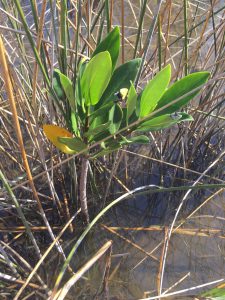
Worldwide, mangrove trees are moving from warmer climates into temperate habitats as climate changes. Photo credit: Carrie Stevenson, UF IFAS Extension
Recent changes in climate are also becoming a factor for human and wildlife behavior. I find myself “migrating” into the air conditioning more often in these dog days of August as 110°+ heat indices bear down. The European heat wave this summer resulted in record-breaking temperatures and at least 8 deaths. Many European countries have never needed air conditioning, so homes, public transportation, and vehicles provide no relief from the sweltering heat. Wildlife, by contrast, cannot move indoors. As the planet warms, some wildlife living in temperate regions may move because their homelands slowly turn subtropical. When this happens, history shows us that humans either “persecute, protect, or ignore” new species, which may result in great success or the downfall of species seeking new habitat. In addition, biologists have been observing and expecting many tropical species of plants and animals to expand into new, warmer territories, as formerly cold climates heat up and become more suitable for particular species to thrive. Mangroves, for example, are migrating beyond the equator worldwide, while the National Oceanic and Atmospheric Administration (NOAA) Arctic report card has shown that the melting of polar ice caps has literally broken up polar bear habitat, along with reducing populations of grazing herds of caribou and reindeer.
Keep in mind that neither one hot summer nor one cold winter define the pace of climate change. The issue at hand is the long-term change. We find ourselves, in August 2019, having just experienced the hottest July (globally) on record since worldwide recordkeeping began in 1880. Some may see this as a fluke, until we consider that NOAA and NASA data show that 17 of the 18 warmest years have occurred since 2001. The patterns are changing—and as always, we humans must adapt. It is important that our adaptation includes mitigation measures, which can range from reducing energy use to planting more trees. To learn more about changes in worldwide climate and what you can do to make a difference, visit the NOAA site https://www.climate.gov/
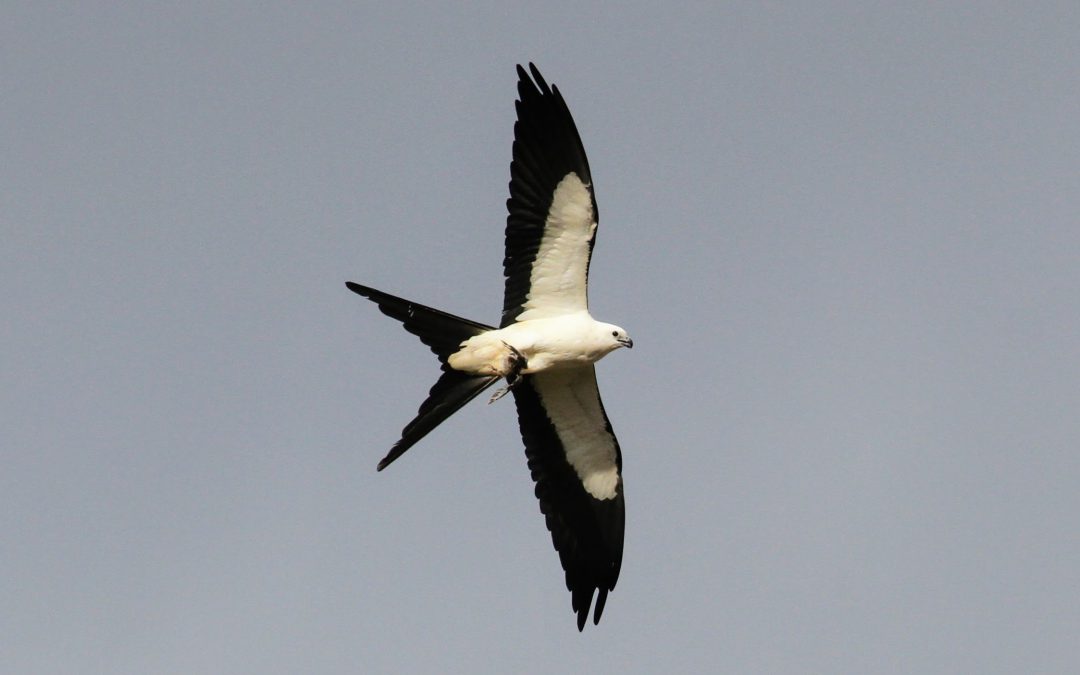
by Erik Lovestrand | Jun 21, 2019
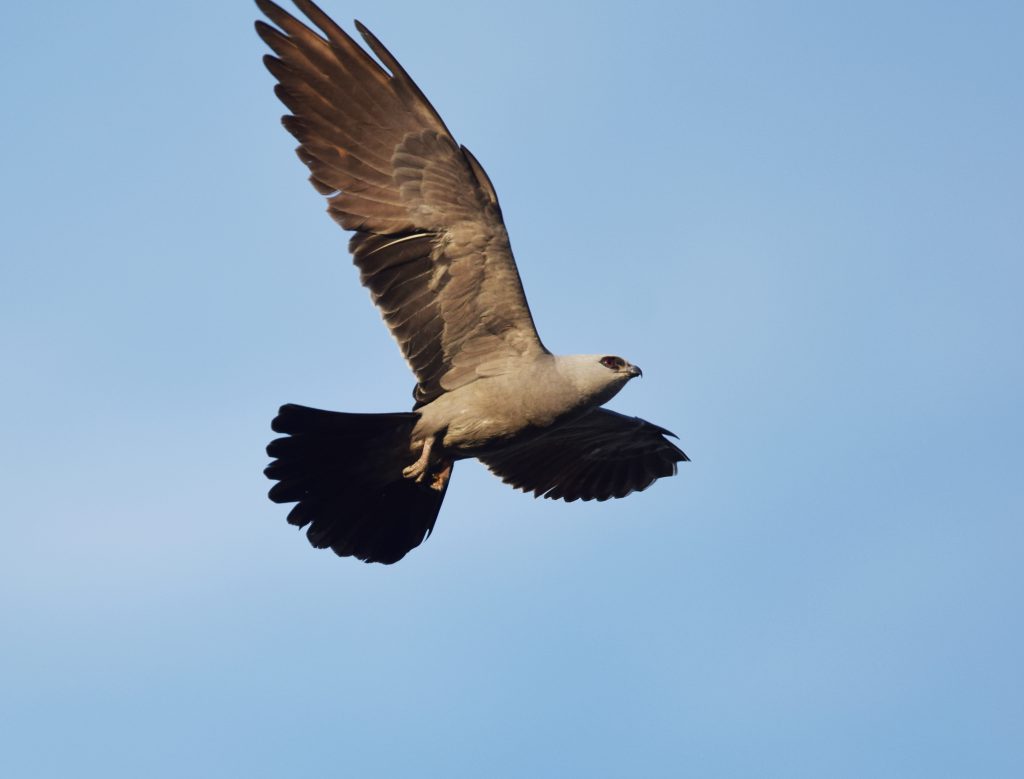
Mississippi kites are smaller but impressive aerialists as well. Photo by Andy Reago, Flickr Creative Commons.
Dime store kites were never very expensive, but it still seemed like a luxury when I was growing up and it was a rare thing for us kids to see a store-bought kite flying over our neighborhood. An old paper grocery bag (remember those), some cotton string for the corner loops, and two dog fennel sticks cut from the back field provided the basic ingredients for us to make our own. With a little creative cutting and gluing, and the attachment of a tail made from torn strips from a worn-out shirt, it was a thing of grace and beauty and was soon aloft on the wind. On a good day, with the right breeze (not too light, not too gusty), we could run out two full rolls of kite string until the kite was just a speck in the distance. The real challenge was winding all of that string back in after the kite came down across houses, powerlines and fields.
Please forgive the digression but thinking about the topic for this article sent me on a little trip down memory lane. We are fortunate to have two very interesting avian species of kites that grace our summer skies over North Florida. Both are exceptional aerialists but one of them in particular will leave a visual image that is hard to shake. The swallow-tailed kite (Elanoides forficatus) is one of the most impressive birds on the planet with its stark white belly and under-wing coverts, outlined in bold black trim. Its deeply forked tail gives rise to several descriptive names such as split-tailed hawk and fork-tailed hawk, among others. Each spring, swallow-tailed kites migrate in small groups back to their breeding range that extends into the Florida Peninsula and sections of the Panhandle, including several North Florida counties. I’ve seen up to 21 kites flying over the Apalachicola River floodplain during this time of year. Forested swamp habitats along river corridors are particularly valuable for foraging and nesting areas but these graceful flyers are also observed over agricultural fields and pastures where they catch dragonflies and other bugs on the wing; usually dining in the air. Nesting takes place in treetops and young are fed a mixed bag of insects, tree frogs, lizards and small snakes, most snatched from the treetops in flight. Occasionally, the young of other birds are taken from their nests and added to the menu. After the young have fledged from the nest, it isn’t long before our kites head back to their wintering grounds in South America. Young birds can be identified by their less-deeply forked tail, due to the short outer tail feathers.
The other kite that graces our area during summertime is the Mississippi kite (Ictinia mississippiensis); not quite as flashy as its fork-tailed cousin but beautiful in its own right. Adult Mississippi kites are a pearly gray color with darker wings and tail. They are significantly smaller, with a wingspan of about 3 feet (swallow-tailed kites have a wingspan up to 4.5 feet). Wintering grounds are in South America also but the breeding range in the US includes several western states such as Texas, Oklahoma and even sparsely in New Mexico and Arizona. This species is known to vigorously defend its nest by dive-bombing trespassers who get too close.
I see both species flying around my house in Wakulla County and without fail, I pause to appreciate the grace, beauty and tremendous distances covered during annual flights by these long-distance migrants. Keep looking up during our summer months and you may well be rewarded by a glimpse of these two “kites over North Florida.”
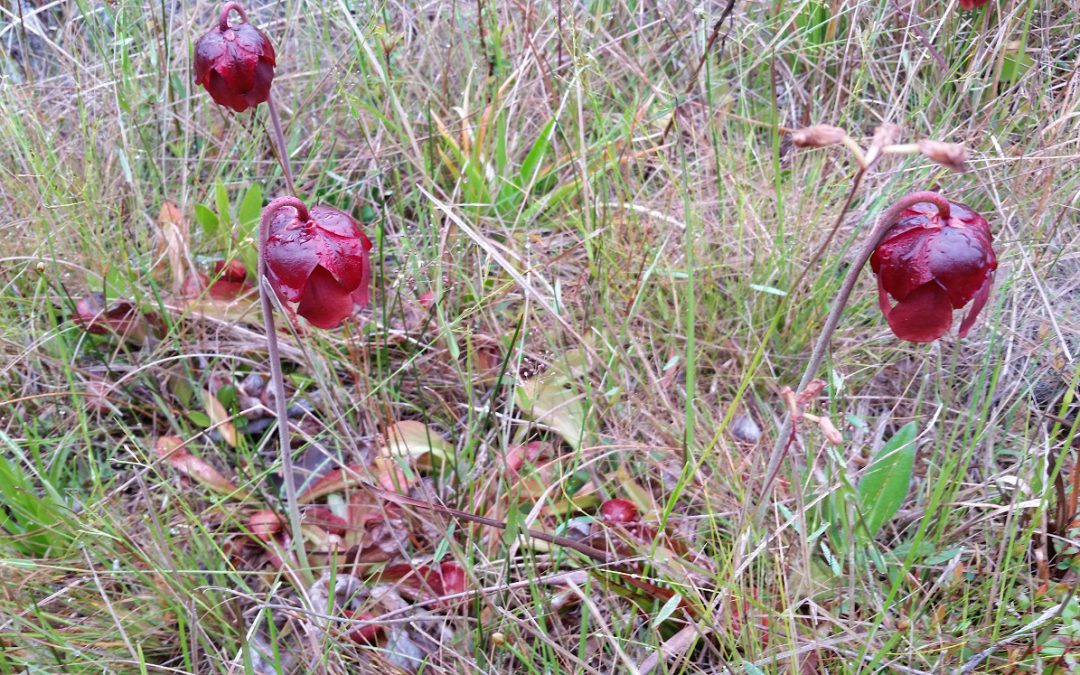
by Erik Lovestrand | May 31, 2019
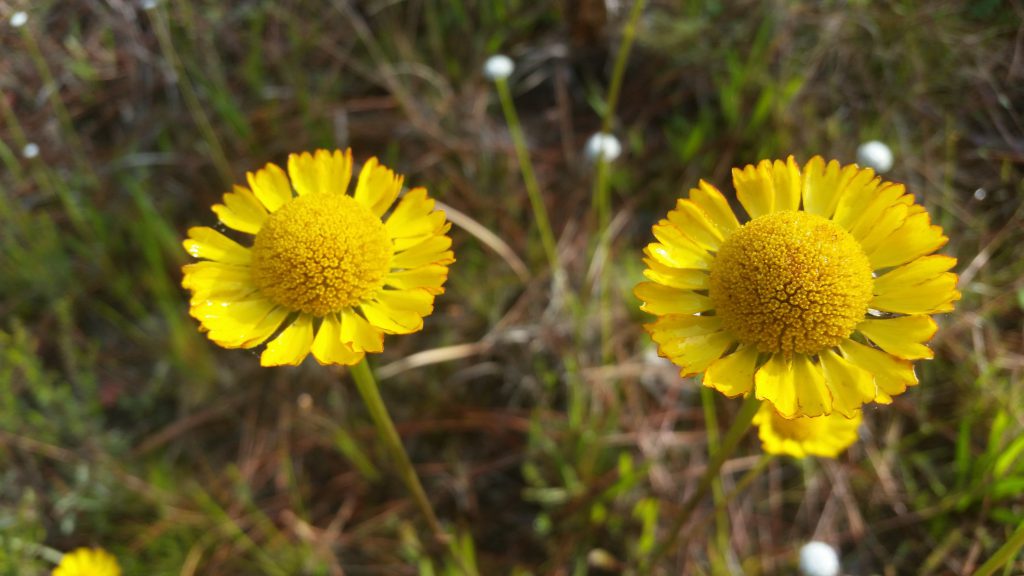
Yellow asters such as sneezeweed bloom profusely during summertime in the flatwoods.
Our coastal habitats are some of the most beautiful on the planet. Where else can you have the breathtaking, wide open vistas of our salt marshes, the incredible productivity of our nearshore bays, and the expansive pinelands in the adjacent uplands. Year-round opportunities abound to be outside and enjoy the natural resources we are blessed with. Just go prepared for the inevitable encounter with some of our bloodsucking flies and midges that are part of the package deal. A pair of binoculars, snacks, water and proper clothing provide the makings of a great day out, but I would also recommend a picture-taking device of some sort. I’ve basically given up on the heavier camera gear and the notion of getting long-distance close-ups. I now rely on my cell phone or a small digital camera; mainly for taking photos of flowers, bugs, and anything else that doesn’t require stealth and patience to shoot.
One of the best habitats to explore during this time of year for capturing memorable images is the upland pine flatwoods that is so abundant in the Florida Panhandle. There is no shortage of public lands that display some of the most well-managed pineland landscapes in the nation. Pineland ecosystems in the Southeast have been intimately linked with a natural fire regime, long before Europeans came on the scene. Successional cycles of increasing shrubby growth over time and the ability of the landscape to carry a fire after a lightning strike, have allowed these areas to develop with the “park-like” vista of a pine tree savanna in many cases. When fire is excluded by people, these ecosystems gradually convert to more hardwood species that tend to shade-out herbaceous growth on the ground and reduce the opportunity for new pine seedlings to become established. Professional land managers who work hard to mimic natural fire cycles on the lands they manage produce some astounding results. I can attest, as many of the areas where I hunt turkeys each spring are chosen more for the beauty of the landscape than the abundance of gobblers. Although fewer gobblers is not typically the ideal hunting scenario, the silver lining comes in the form of less competition with other hunters.
This spring I hunted in part of the St. Marks National Wildlife Refuge and had a nice mix of fairly recently burned pinelands to explore. Some were burned this spring, and was just starting to green-up with newly emerging grasses and forbs. Other areas were burned a year or two ago and you would never know it except for the charred bark on tree trunks. These areas recover to full greenery in a very short time. The foot-high wild blueberry bushes were loaded with green berries for summer wildlife feasts to come, and the photo opportunities for wildflowers abounded. Fire is so important in retaining a high species diversity in these habitats. Opening up the canopy allows sunlight to filter through to the forest floor and the recycling of nutrients in the ash supports many unique plants. There are several terrestrial orchids that bloom in the wetter soils (grass pink, colic root, lady’s tresses, etc.), and yellow flowers are prolific right now (St. John’s wort, sneeze weed, candy root and many more). I even saw some parrot pitcher plants in one wet spot, noticeable mainly by their tall maroon flowers. Fetterbush and staggerbush are also blooming with small flowers that look similar to blueberry blooms. The difference in scent of these two Lyonia shrubs is an easy way to tell them apart with fetterbush having a strong musky (not totally unpleasant) smell, while staggerbush (rusty Lyonia) has one of the sweetest, most pleasant smells of spring in the flatwoods.
So, while I did have the opportunity to chase around a gobbler this spring (who easily out-maneuvered me), I truly enjoyed my week of annual leave spent reconnecting with something that we too often take for granted. Take time to locate the state parks, national wildlife refuges, state forests and other public lands in your region. Then go outside. I mean it; none of us should miss the chance of a lifetime to see what we really have here.
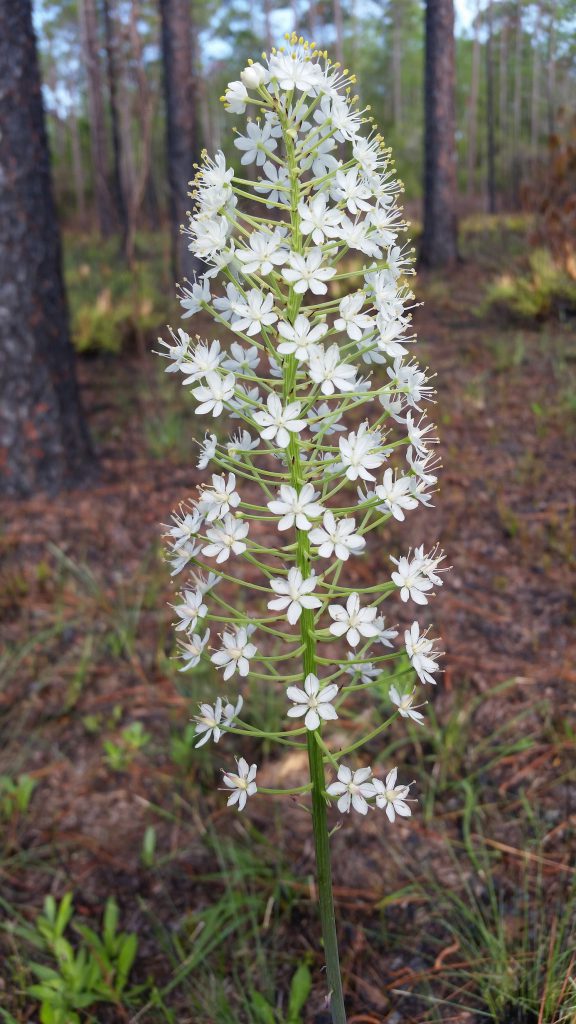
Crow poison, also know as Osceola’s plume shows up in wet flatwoods, most noticeably after a fire.
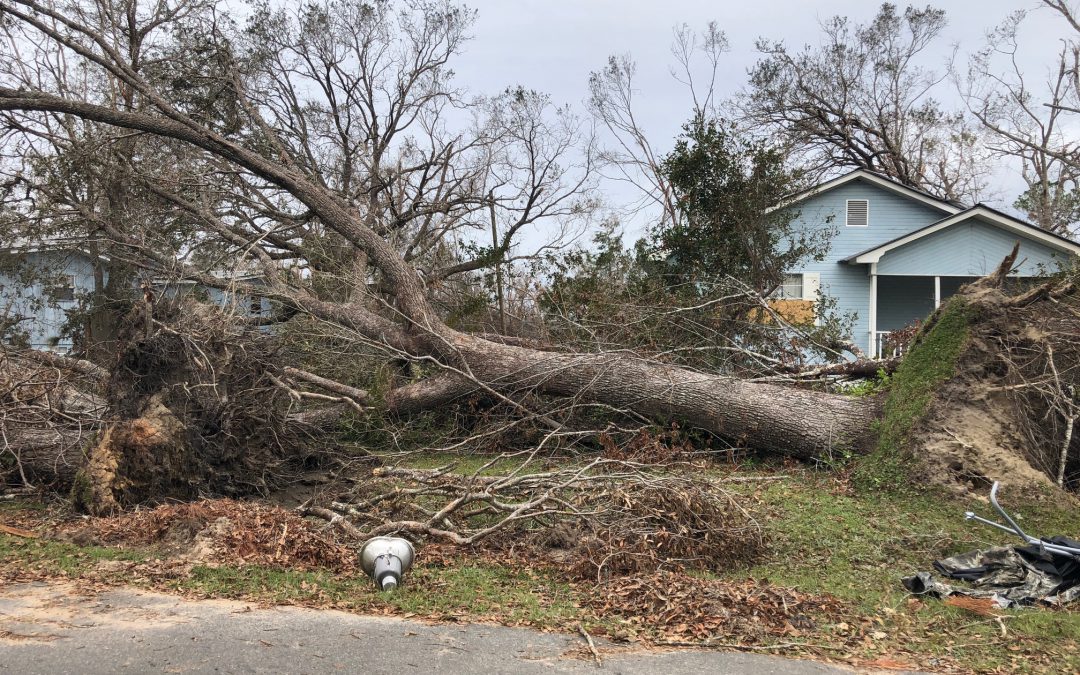
by Carrie Stevenson | May 17, 2019
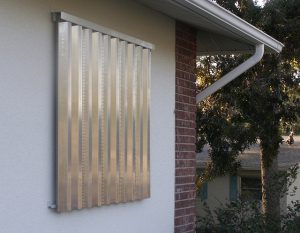
Aluminum shutters are one of the many preventative measures panhandle homeowners can include in their hurricane preparedness.
Photo: Carrie Stevenson
Hurricane Season in the Gulf and Atlantic begins June 1. For those of us who have lived in hurricane territory for some time, we all have our war stories of days without electricity and water, of being stuck in evacuation traffic, and of neighborhood camaraderie in the aftermath. Whether a newcomer or a native, it is always important to plan ahead and not be complacent about storm readiness. The last few summers have borne out the climate predictions of stronger storms, with many of our neighbors still struggling to dig out of the immense damage done by Category 5 Hurricane Michael last fall.
In this article, I will be paraphrasing a section from the well-done Homeowners Handbook to Prepare for Natural Hazards. A new version of this guide will be coming out soon, but I highly recommend the handbook (hard copies available at many Extension offices) for anyone living in Florida.
Tip #1: Gather your emergency supplies. Do this sooner than later—when a storm is in the Gulf with a trajectory towards your city is not the time to go shopping. Lines will be long, people will be stressed, and shelves will start to empty. Gather emergency supplies like water, canned goods, batteries, and flashlights (full list here) now, and restock monthly throughout the summer and fall.
Tip #2: Create a separate evacuation plan for natural events, such as hurricanes/tropical storms, tornadoes, floods, and wildfires. Northwest Florida is prone to all of these natural phenomena, and the plan required for each is different. For a tornado or tropical storm you will most likely shelter in place (unless your home is not secure in this situation), while fires, flooding, and strong hurricanes may require securing your home and leaving town.
Tip #3: Know you property and take appropriate action. Look at your location—if the land floods during a rain, consider flood insurance. If trees overhang your house, consider trimming or cutting branches that might damage your house in a storm. If the property has a high structural profile, it could be especially susceptible to wind damage in a hurricane.
Tip #4: Know your house and take appropriate action. When was your house built? Does it have connectors to tie the roof to the wall or the wall to the foundation? When will you need to reroof? Look at your blueprints—if you don’t have a copy, your homebuilder or local building department may have copies.
Tip #5: Strengthen your house. A house built after the early to mid-1990’s should have hurricane clips tying the roof to the wall and strong connectors from the wall to the foundation. If your house was built before then, you can still retrofit at a reasonable cost. Wind-rated garage doors, precut shutters, and replacing windows with impact-resistant glass can all protect your home. In the western Panhandle, 75% of retrofit costs can be covered through the Rebuild Northwest Florida wind mitigation program.
Tip #6: Utilize the State of Florida’s Hazard Mitigation Grant Program. This program can be used for a number of home improvements, including construction of a safe room for tornado shelter.
Tip #7: Insurance. Don’t gamble with your house. Obtain adequate wind, flood, and home insurance. Remember—if there is a hurricane in the Gulf, insurance companies will not issue windstorm policies.
Tip #8: Take advantage of potential discounts for your hurricane insurance premiums. Coverage may vary among insurance companies, so call you insurance agent to find out about discounts that may be available. Significant discounts may be provided for reducing the risk to your house with window protection, roof-to-wall tie downs, and wall-to-foundation tie downs.
Tip #9: Finance creatively. Consider efforts to strengthen your house as an important home improvement project. Most projects are not that expensive. For the most costly ones, a small home improvement loan and potential discounts from hurricane insurance premiums may make these projects within reach. It is a great investment to strengthen your house and provide more protection to your family.
Tip #10: Seek the assistance of a qualified, license architect, structural engineer, or contractor. There are some improvements that can be done yourself, but if you cannot do the work, seek qualified assistance through trusted references from friends and family and professional associations.
For more information, reach out to your county Emergency Management department or visit these IFAS Extension Hurricane Preparedness and Recovery resources.

by Laura Tiu | May 3, 2019
There are five species of sea turtles that nest from May through August on Florida beaches, with hatching stretching out until October. The loggerhead, the green turtle, and the leatherback all nest regularly in the Panhandle, with the loggerhead being the most frequent visitor. Two other species, the hawksbill and Kemp’s Ridley nest infrequently. All five species are listed as either threatened or endangered under the Endangered Species Act. Due to their threatened and endangered status, the Fish and Wildlife Conservation Commission/Fish and Wildlife Research Institute monitors sea turtle nesting activity on an annual basis.

A group checks out a recently hatched sea turtle nest on the dunes in south Walton county in Florida.
Annual total nest counts for loggerhead sea turtles on Florida’s index beaches fluctuate widely and scientists do not yet understand fully what drives these changes. From 2011 to 2018, an average of 106,625 sea turtle nests (all species combined) were recorded annually on these monitored beaches. In 2018, there was a slight decrease in nests with only 96,945 nests recorded statewide. This is not a true reflection of all of the sea turtle nests each year in Florida, as it doesn’t cover every beach, but it gives a good indication of nesting trends and distribution of species.
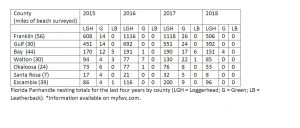
2015-2018 Florida Panhandle turtle nesting totals for all species.
If you want to see a sea turtle in the Florida Panhandle, please visit one of the state-permitted captive sea turtle facilities listed below, admission fees may be charged. Please call the number listed for more information.
- Gulf Specimen Marine Laboratory
222 Clark Dr
Panacea, FL 32346
850-984-5297
Admission Fee
- Gulf World Marine Park
15412 Front Beach Rd
Panama City, FL 32413
850-234-5271
Admission Fee
- Gulfarium Marine Adventure Park
1010 Miracle Strip Parkway SE
Fort Walton Beach, FL 32548
850-243-9046 or 800-247-8575
Admission Fee
- Navarre Beach Sea Turtle Center
8740 Gulf Blvd
Navarre, FL 32566
850-499-6774
The Foundation for The Gator Nation. An Equal Opportunity Institution

by Andrea Albertin | May 3, 2019
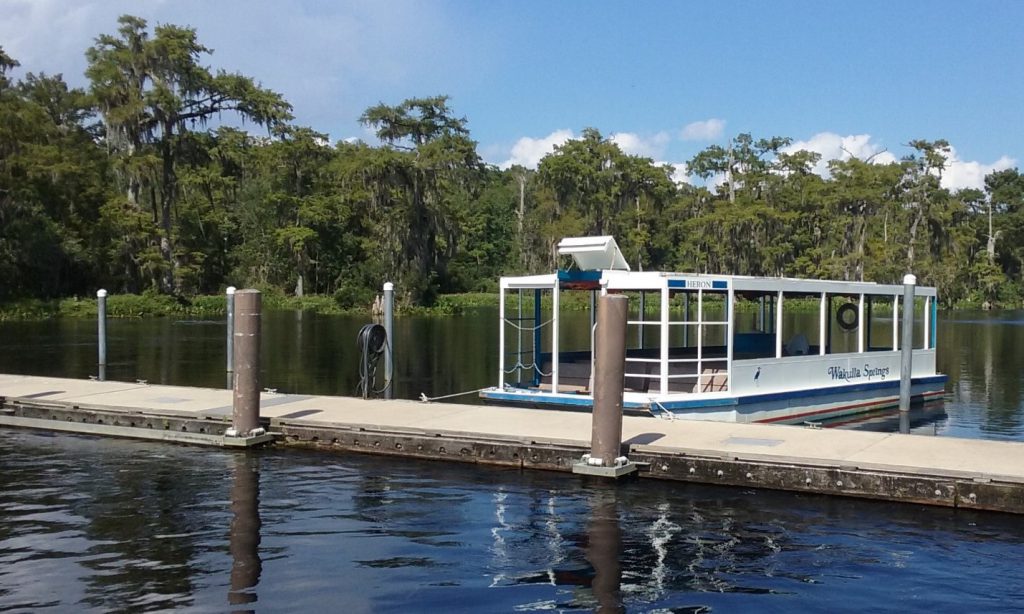
The major goal of the Wakulla Springs Basin Management Action Plan (BMAP) is to reduce nitrogen loads to Wakulla Springs. Septic systems are identified as the primary source of this nitrogen. Photo: A. Albertin
A Basin Management Action Plan, or BMAP, is a management plan developed for a waterbody (like a spring, river, lake, or estuary) that does not meet the water quality standards set by the state. One or more pollutants can impair a waterbody. In Florida, the most common pollutants are nutrients (particularly nitrate), pathogens (fecal coliform bacteria) and mercury.
The goal of the BMAP is to reduce the pollutant load to meet water quality standards set by the Florida Department of Environmental Protection (FDEP). BMAPS are roadmaps with a list of projects and management action items to reach these standards. FDEP develops them with stakeholder input. Targets are set at 20 years, and progress towards those targets is assessed every five years.
It’s important to understand that a BMAP encompasses the entire land area that contributes water to a given waterbody. For example, the land area that contributes water to Jackson Blue Springs and Merritts Mill Pond (either from surface waters or groundwater flow) is 154 square miles, while the Wakulla Springs Basin covers an area of 1,325 square miles.
BMAPs in the Panhandle
There are 33 adopted BMAPS in the state, and 5 that are pending adoption. Here in the Panhandle, we have three adopted BMAPS. They are the Bayou Chico BMAP in Escambia County, the Wakulla Springs BMAP in Wakulla, Leon, Gadsden and small parts of Jefferson County, and the Jackson Blue/Merritts Mill Pond BMAP in Jackson County. All three are impaired for different reasons.
- Bayou Chico discharges into Pensacola Bay and is polluted by fecal coliform bacteria. The BMAP addresses ways to reduce coliforms from humans and pets, which includes sewer expansion projects, stormwater runoff management, septic tank inspections, pet waste ordinances and a Clean Marina and Boatyard program.
- Wakulla Springs Nitrate from human waste is the main pollutant to Wakulla Springs, and Tallahassee’s wastewater treatment facility and the city’s Southeast Sprayfield were identified as the main sources. Both sites were upgraded (the sprayfield was moved), greatly reducing nitrate contributions to the spring basin. The BMAP is focused on septic systems and septic to sewer hookups.
- Jackson Blue/Merritts Mill Pond Nitrate is also the primary pollutant to the Jackson Blue/Merritts Mill Pond Basin, but nitrogen fertilizer from agriculture is identified as the main source. This BMAP focuses on farmers implementing Best Management Practices (BMPs), land acquisition by the Northwest Florida Water Management District , as well as septic tanks, recognizing their nitrogen contribution to Merritts Mill Pond.
Once all the BMAPS are adopted, FDEP states that almost 14 million acres will be under active basin management, an area that includes more than 6.5 million Floridians.

Adopted and pending BMAPS in Florida. Source: FDEP Statewide Annual Report, June 2018
How are residents living in an area with a BMAP affected? It varies by BMAP and specifically land use within its boundaries. For example, in BMAPs where nitrogen from septic systems are found to be a major source of nutrient impairment to a water body, septic to sewer hookups, or septic system upgrades to more advanced treatment units will be required in specific areas. In urban areas where nitrogen fertilizer is an important source, municipalities are required to adopt fertilizer ordinances. Where nitrogen fertilizer from agricultural production is a major source of impairment, producers are required to implement Best Management Practices to reduce nitrogen loads.
More information about BMAPS
For specific information on BMAPS, FDEP has an excellent website: https://floridadep.gov/dear/water-quality-restoration/content/basin-management-action-plans-bmaps All BMAPs (full reports with specific action items listed) can be found there, along with maps, information about upcoming meetings and webinars and other pertinent information.
Your local Health Department Office is the best resource regarding septic systems and any ordinances that may apply to you depending on where you live. Your Water Management District (in the Panhandle it’s the Northwest Florida Water Management District) is also an excellent resource and staff can let you know whether or not you live or farm in an area with a BMAP and how that may affect you.
















